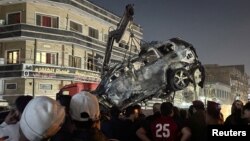The United States military says it carried out a drone strike on a vehicle in Baghdad, killing a leader of an Iranian-backed militant group.
U.S. Central Command, which oversees U.S. military operations in the Middle East, said the strike on Tuesday killed a commander of the militant group Kataib Hezbollah who was “responsible for directly planning and participating in attacks on U.S. forces in the region.”
Two U.S. officials confirmed to VOA that the commander was operations officer Wisam Mohammad al-Saedi. Photos on social media allegedly showed his Iraqi identification card that was pulled from his body.
VOA had earlier reported the United States military was involved in an airstrike against a high-value target in the Middle East but had not identified al-Saedi by name.
Video shared on social media showed a vehicle engulfed in flames on a Baghdad highway.
The U.S. strike was in response to the almost 170 drone, rocket and missile attacks against U.S. forces in the Middle East since mid-October, one of which killed three U.S. service members and wounded dozens more in northern Jordan last week.
A wave of U.S. airstrikes in Iraq and Syria on Friday pounded targets associated with Iranian-backed militias responsible for the attacks. The strikes targeted three locations in Iraq, as well as another four in Syria, and they destroyed more than 80 individual targets, ranging from command-and-control centers and intelligence hubs to missile and drone storage facilities, according to the latest U.S. assessments.
But while U.S. officials have defended the strikes as necessary following a drone attack that killed three U.S. soldiers at a base in Jordan last month, Iraqi officials have voiced increased anger, summoning the U.S. chargé d'affaires in Baghdad to protest. They have charged that some of the U.S. strikes hit elements of Iraq’s own security forces.
The U.S. State Department said Monday that Iraq was not given any warning but added the U.S. strikes should not have come as a surprise.
Pentagon press secretary Major General Pat Ryder said Monday the U.S. had no plans for a long-term military campaign against the militias in Iraq and Syria, but he noted the U.S. response to the killing of its service members was “not complete.”
The U.S. has about 2,500 troops in Iraq tasked with advising and assisting Iraqi security forces as they pursue the remnants of the Islamic State terror group, also known as ISIS or Daesh.
And while talks between the U.S. and Iraq are underway to eventually reduce the U.S. military footprint and transition from the counter-IS mission to what officials describe as more traditional military-to-military relationship with Baghdad, the process has been complicated by the attacks.
On Tuesday, Iranian-backed Houthi militants once again ignored U.S. calls to stop attacking international shipping lanes or face consequences, this time firing six anti-ship missiles from Houthi-controlled areas of Yemen into the Red Sea and the Gulf of Aden.
U.S. Central Command said late Tuesday that one of the missiles caused minor damage to the Marshall Islands-flagged, Greek owned-and-operated bulk carrier MV Star Nasia in the Gulf of Aden, while another missile landed in the water near the ship. U.S. forces shot down a third missile in the area.
There were no reported injuries, and the ship was able to continue toward its destination, CENTCOM said in a statement.
In the southern Red Sea, CENTCOM said three missiles likely targeting the Barbados-flagged, U.K.-owned cargo ship MV Morning Tide landed in the water without causing any damage.
The latest Houthi launches came as an unclassified Defense Intelligence Agency report released Tuesday confirmed that Houthi militants in Yemen were using various missiles and drones of Iranian origin in its recent attacks across the region. The report compares publicly available images of Iranian weapons to those employed by the Houthis and highlights the strengthening relationship between the Houthis and Iran’s Islamic Revolutionary Guard Corps.
Earlier Tuesday, the U.S. military said it conducted its latest self-defense strikes against two Houthi kamikaze drone boats that were laden with explosives.
CENTCOM, which oversees U.S. forces in the region, said the vessels “presented an imminent threat to U.S. Navy ships and merchant vessels in the region.”
The Houthis have said their Red Sea attacks are in solidarity with the people of Gaza and have vowed to continue them, despite the U.S. and British strikes.





